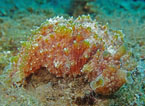| Home |
| Acknowledgments |
| Conventions |
| Glossary |
| Maps |
| References |
| Links |
| Articles |
| Thumbnails |
| Species
list |
| Family |
| Next
species |
Additional Photos

posterior disk

front

top

white flecks

mating

Dolabella sp. #1

| Maximum size: about 300 mm (?). (Note 1) Identification: This species is similar to Dolabrifera auricularia. However, it differs from that species on several points. The tubercles are larger and more conical with less development of secondary tubercles. The posterior disk has a thin and deeply scalloped margin. The rhinophores are longer with more asymmetrical tips while the cephalic tentacles are more broadly flared with less-ruffled tips. The eye spots are smaller with narrower (though better defined) clear rings surrounding them. The body is decorated with "military-style" camouflage composed of sharply defined brown patches of various hues. The primary tubercles are gray, frosted with yellow-white apically. The cephalic tentacles have cream borders. Some animals may be covered with minute white flecks and the tubercles (as well as the rhinophores and cephalic tentacles) may show a greenish apical tinge. Dark animals in which the dark pigment obscures some elements of the pattern may also occur. (Note 2) Natural history: Dolabella sp. #1 is a rare species known from four animals found in mixed habitats at 10-18 m (33-60 ft). It's probably primarily active at night but may rest in the open and mate by day. Like D. auricularia, it probably lays a tangled, spaghetti-like egg mass. Distribution: Big Island and Oahu: probably widely distributed in the Indo-Pacific. (Note 3) Taxonomic notes: We previously considered this species to be a form of D. auricularia. However, it differs from typical animals of that species based on a cluster of well-correlated traits. That suggests it's distinct (although it will probably take DNA work for confirmation). It was first recorded in Hawaii from Kepuhi, Oahu by John Hoover in Oct., 1995. Photo: Ryan Boerema: side, night: Ho'okena, Big Island: July 27, 2022. Observations and comments: Note 1: This species is probably roughly the same size as D. auricularia. Note 2: Based on a photo from Mauritius (by Geoffrey Summers, on Philibert Bidgrain's site) that shows paired light and dark animals that are, otherwise, morphologically similar.. Note 3: There are photos on-line of similar animals from Mauritius (by Geoffrey Summers, on Philibert Bidgrain's site) and from several locations in the western Pacific (such as Scott Johnson's Bali site). |
| Thumbnails |
Species
list |
Family | Next species | Top |